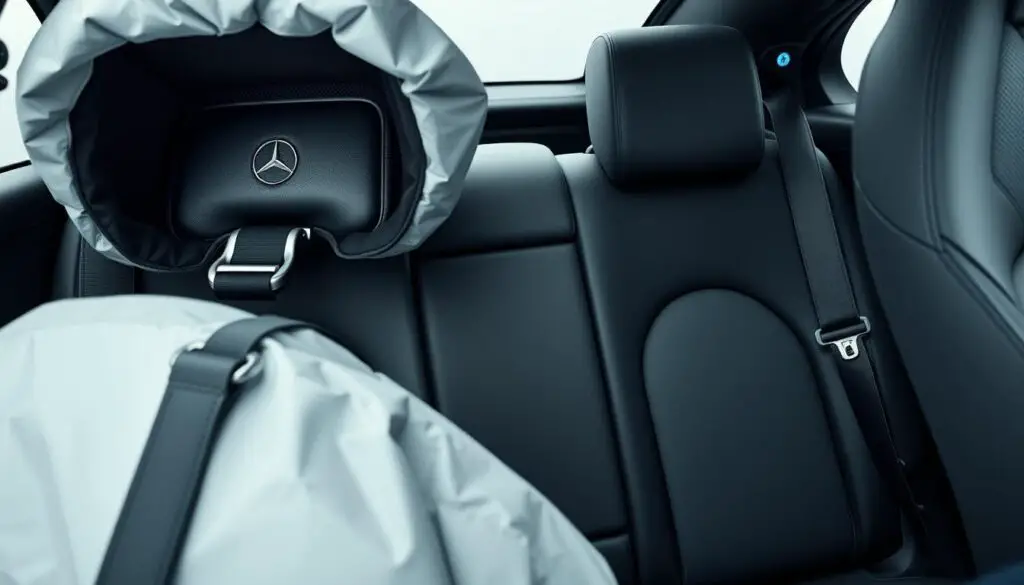The Mercedes restraint system is a vital safety feature designed to protect vehicle occupants during collisions. Issues with this system can lead to malfunctions, potentially putting occupants at risk. Understanding the components and functions of this system is crucial for maintaining vehicle safety.
When the restraint system malfunctions, it can be due to various reasons, including faulty sensors or worn-out components. Addressing these issues promptly is essential to ensure the vehicle’s safety features are functioning correctly.
Key Takeaways
- Understanding the Mercedes restraint system is crucial for vehicle safety.
- Common issues include faulty sensors and worn-out components.
- Prompt maintenance is essential to prevent malfunctions.
- The restraint system’s proper functioning is vital for occupant protection.
- Regular checks can help identify potential problems early.
Understanding the Mercedes Restraint System
A comprehensive understanding of the Mercedes restraint system is essential for diagnosing and resolving potential issues. The restraint system is a critical safety feature that includes various components working together to protect vehicle occupants during collisions.
Components of the Mercedes Restraint System
The Mercedes restraint system comprises several key components, including airbags, crash sensors, and control units. These elements work in tandem to detect crashes and deploy airbags accordingly. The airbag system is designed to inflate rapidly in the event of a collision, cushioning the impact for occupants.

How the Restraint System Works
The restraint system operates through a complex interplay of sensors and control units. When a crash occurs, crash sensors detect the impact and send signals to the control unit, which then deploys the necessary airbags. This process happens rapidly, often in a matter of milliseconds, to provide optimal protection.
“The airbag system is a crucial component of the restraint system, designed to work in conjunction with seatbelts to minimize injury risk.” –
Variations Across Mercedes Models
The configuration of the restraint system can vary significantly across different Mercedes models. Newer models often feature more advanced restraint systems, including additional airbags and sophisticated crash detection algorithms. For instance, some models may include knee airbags or side curtain airbags, enhancing overall safety. For those interested in similar safety features in other vehicles, understanding restraint system malfunctions in BMW can provide valuable insights.
Restraint System Malfunction in Mercedes: Causes and Solutions
A malfunctioning restraint system in a Mercedes can lead to serious safety issues, making it crucial to understand the warning signs. The restraint system is a complex network of airbags, seatbelt pretensioners, and sensors designed to work together to protect occupants in the event of a collision.

Common Warning Signs and Dashboard Indicators
When the restraint system malfunctions, it often triggers warning signs on the dashboard, such as the “Restraint System Malfunction” warning light. For more information on dashboard symbols, you can visit this resource. Other indicators may include warning messages or illuminated airbag lights.
These warning signs are critical indicators that the restraint system is not functioning correctly. Ignoring these signs can lead to reduced safety in the event of an accident.
Primary Causes of Restraint System Failures
The primary causes of restraint system failures in Mercedes vehicles can vary, but common issues include faulty sensors, software glitches, and worn-out components. Faulty sensors can provide incorrect data to the restraint system’s control module, leading to malfunctions.
Software glitches can occur due to outdated software or corrupted data, affecting the system’s ability to function correctly. Regular software updates can help mitigate this issue.
Initial Troubleshooting Steps for Safety
When faced with a restraint system malfunction, initial troubleshooting steps are crucial for safety. Start by checking the dashboard for any warning lights or messages. If the “Restraint System Malfunction” light is on, try restarting the vehicle to see if the issue resolves itself.
If the problem persists, it’s essential to consult a professional Mercedes service center for further diagnosis and repair. They have the necessary tools and expertise to identify and fix complex issues with the restraint system.
Diagnosing Specific Restraint System Problems
To effectively diagnose restraint system problems in Mercedes vehicles, one must be equipped with the right tools and knowledge. The restraint system is a critical safety feature, and its malfunction can have serious implications. Therefore, understanding how to diagnose issues accurately is paramount.
Using OBD Scanners and Mercedes-Specific Diagnostic Tools
Modern Mercedes vehicles are equipped with advanced onboard diagnostics (OBD) systems that can be accessed using OBD scanners. These scanners are invaluable for retrieving error codes related to the restraint system. Mercedes-specific diagnostic tools take it a step further by providing detailed insights into the system’s performance and fault areas. Using these tools, technicians can quickly identify issues and begin the repair process.
Interpreting Error Codes and Fault Patterns
Once error codes are retrieved, interpreting them correctly is crucial. Error codes related to the restraint system can indicate a range of issues, from sensor malfunctions to problems with the airbag control module. Understanding these codes and recognizing fault patterns can help diagnose the root cause of the problem. It’s essential to consult the vehicle’s repair manual or a database of error codes specific to Mercedes vehicles to ensure accurate diagnosis.
When to Seek Professional Mercedes Service
While some restraint system issues can be diagnosed and resolved by vehicle owners, more complex problems require professional attention. If the issue persists after initial diagnosis or if you’re unsure about how to proceed, it’s advisable to seek the services of a certified Mercedes technician. They have the training, experience, and access to Mercedes-specific diagnostic equipment to resolve complex issues efficiently.
DIY Solutions for Mercedes Restraint System Issues
For many Mercedes drivers, addressing restraint system malfunctions doesn’t always require a trip to the mechanic. With the right knowledge and tools, owners can implement DIY solutions to resolve common issues, ensuring their vehicle’s safety features are functioning properly.
Step-by-Step Guide to Resetting the Restraint System
One of the simplest DIY solutions is resetting the restraint system. This process can resolve issues caused by software glitches or temporary faults. To reset the system, start by turning off the engine and removing the key from the ignition. Wait for a few minutes to allow any residual power to dissipate. Then, reinsert the key and turn the ignition to the “ON” position without starting the engine. Use your Mercedes’ dashboard controls to navigate to the “Vehicle Settings” or “Safety Settings” menu and look for the option to reset the restraint system. Follow the on-screen instructions to complete the reset process.
It’s essential to consult your owner’s manual for specific instructions, as the process may vary depending on your Mercedes model. If the issue persists after resetting, it may indicate a more serious problem requiring further diagnosis.
Replacing Faulty Sensors and Components
If resetting the system doesn’t resolve the issue, the next step is to inspect and potentially replace faulty sensors and components. Common culprits include worn-out or damaged seatbelt buckles, faulty crash sensors, or malfunctioning airbag control units. Begin by checking the condition of your seatbelts and buckles. If they’re damaged, replacing them is usually a straightforward process that can be done at home with basic tools.
For more complex components like crash sensors or airbag control units, it’s crucial to refer to a professional if you’re not experienced with automotive repairs. These parts are critical to the safety of your vehicle, and improper installation can lead to serious consequences.
Preventative Maintenance to Avoid Future Problems
Preventative maintenance is key to avoiding future restraint system issues. Regularly check your vehicle’s seatbelts for signs of wear and ensure that all buckles and retractors are functioning correctly. Keep your Mercedes’ software up to date, as manufacturers often release updates that can improve the performance and reliability of safety systems.
- Regularly inspect seatbelts and buckles for damage or wear.
- Keep your vehicle’s software up to date.
- Avoid using aftermarket accessories that haven’t been certified by Mercedes.
By following these DIY solutions and maintaining a proactive approach to vehicle maintenance, Mercedes owners can significantly reduce the likelihood of restraint system malfunctions and ensure their vehicle remains safe and reliable.
Conclusion
Ensuring the Mercedes restraint system is functioning correctly is crucial for the safety and performance of the vehicle. By understanding the system, diagnosing issues, and applying DIY solutions or seeking professional help when needed, Mercedes owners can guarantee their vehicle’s safety features are operating as intended.
Regular restraint system maintenance is vital to prevent potential failures and ensure the vehicle’s occupants are protected. Mercedes owners should stay vigilant for warning signs and dashboard indicators, addressing any issues promptly to avoid compromising the system’s effectiveness.
By following the guidelines outlined in this article, Mercedes owners can take proactive steps to maintain their vehicle’s restraint system, ensuring the Mercedes safety features continue to provide optimal protection on the road.
FAQ
What does the “Restraint System Malfunction” warning light on my Mercedes dashboard mean?
The “Restraint System Malfunction” warning light indicates a problem with the vehicle’s restraint system, which includes airbags, crash sensors, and control units. This warning suggests that the system is not functioning correctly, potentially putting occupants at risk in the event of a collision.
Can I continue driving my Mercedes if the restraint system warning light is on?
It is not recommended to continue driving your Mercedes if the restraint system warning light is on. This warning indicates a potential safety issue that needs to be addressed as soon as possible to avoid risking the safety of the vehicle’s occupants.
How do I reset the restraint system in my Mercedes?
Resetting the restraint system may involve using a diagnostic tool or OBD scanner to clear error codes. The exact steps can vary depending on the Mercedes model and the specific issue. Refer to your vehicle’s manual or consult a professional for guidance on resetting the restraint system.
What are the common causes of restraint system failures in Mercedes vehicles?
Common causes of restraint system failures include faulty sensors, software glitches, worn-out components, and issues with the airbag control unit. Diagnosing the exact cause requires the use of specialized diagnostic tools and potentially, professional assistance.
Can I replace faulty sensors or components of the restraint system myself?
Replacing faulty sensors or components can be done by a skilled DIY owner, but it requires careful adherence to safety guidelines and potentially, specialized tools. For complex issues or if you’re unsure, it’s recommended to seek the help of a professional Mercedes technician.
How often should I perform maintenance on my Mercedes restraint system?
Regular maintenance is crucial for the restraint system’s proper functioning. It’s recommended to check the system during routine vehicle inspections, typically every 10,000 to 15,000 miles, or as specified in your vehicle’s maintenance schedule.
Are there any specific diagnostic tools recommended for diagnosing Mercedes restraint system issues?
Mercedes-specific diagnostic tools, along with OBD scanners, are recommended for diagnosing restraint system issues. These tools can retrieve error codes and provide insights into fault patterns within the system, aiding in accurate diagnosis.
What are the benefits of using a Mercedes-specific diagnostic tool?
Using a Mercedes-specific diagnostic tool provides detailed insights into the vehicle’s systems, including the restraint system. These tools can offer more precise diagnostics and repair information than generic OBD scanners, helping to accurately identify and fix complex issues.


